|
Advanced Tracking and Nature Observation
Class
Fred Holder
"Tracking", says Tom Brown, Jr., "is the
ultimate form of Nature Observation." This is why Tom teaches Nature
Observation in conjunction with his Advanced Tracking Course. The course is five
days long and is made up of extensive lectures plus many field trips to put into
practice what Tom has just told the students.
Tom Brown, Jr. is the author of two books: The Tracker
and The Search. The first tells of Tom's experiences from age 8 to 18 in
the Pine Barrens of New Jersey where he grew up under the guidance of an old
Apache Indian, Stalking Wolf. The Search tells of Tom's experiences from
18 to about 28 when he met married Judy and subsequently started what has become
the largest tracking, nature observation and survival school in the United
States. Tom is currently doing a series of articles in Mother Earth News
and is working on a series of books dealing with wilderness survival, tracking,
etc.
In d the September 1981 issue of Black Powder Times we
reported on the "Standard Class", a survival course taught by Tom
Brown, Jr. Arlene and I had attended that course in July. Then in November 1981
I signed up for the "Advanced Tracking and Nature Observation Course".
The latter course was held at the Buck Creek Campground within walking distance
of the White River southeast of Seattle, Washington. Since there was no
prerequisite for the course, it repeated a lot of the material presented in the
Standard Class. But it went much further into both aspects. The repetition
didn't hurt me at all.
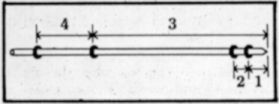 |
The tracking stick will be a slender, round
stick three to four feet in length. It is pointed on one end and is
outfitted with four movable washers (or markers). When measurements are
taken, (1) will be the length of the track, (2) will be the width of the
track, (3) will be the stride or distance between tracks, and (4) will be
the straddle or distance between right and left hand tracks. |
The first half of the class was devoted to Nature Observation
because Tom feels that tracking is much more than just following a set of tracks
until you lose them or find the animal that made them. Tracking is total
observation. Observation of every bent twig, lost hair, rolled stone abraded
bark, and the track itself. Every mark is a track.
All the wisdom is in the last track. It tells you what the
animal was doing, where the next track will be, the sex of the animal, and much,
much more. We learned to look at nature in a different way -- to observe it more
closely and from a different viewpoint. To feel with our hands and feet and walk
in the woods in total darkness without stumbling or falling over things.
| Track measurements to be made
with, and recorded on, the tracking stick. It is unlikely that any two
animals will have exactly the same measurements. |
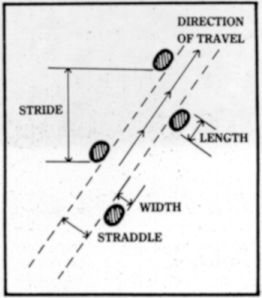 |
In the afternoon we did the blindfold exercise. Then that
night we stalked up a wooded hill in the darkness to try and find an instructor
hidden up there. This was an interesting experience. It was too dark to see your
hand in front of your face -- yet, I was able to find the top of the hill
without falling or running into any trees. I would sense a tree was there and
would put out my hand and it would be there. Before these courses, I could not
have found the top of the hill and I would have stumbled and run into many trees
in such total darkness.
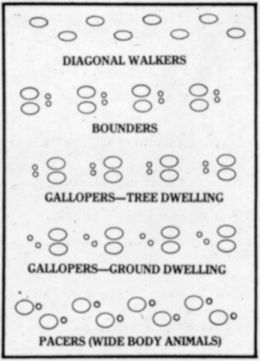 |
There are four basic types of
track patterns when animals are walking. The gallopers fall into two
sub-groups: tree dwelling and ground-dwelling. |
We learned to use what Tom calls "Splatter vision".
This is an unfocused viewing of your surroundings which lets your peripheral
vision do most of the work. It is very good for detecting movement. Something
moves and you focus on it. With this method you can see an eye blink or a skin
ripple, Tom claims. I still haven't mastered it in the woods, but I believe this
is the basic vision I use when driving that allows me to see a ball roll into
the street or a car move in from the side.
Good Nature Observation is best done in an active state of
meditation, the way Tom describes it. All of one's senses are tuned to the
finest degree by total concentration on the moment. All thoughts are suppressed.
Those little internal voices are gone. You become one with your surroundings and
know all that is there. Good tracking requires this total concentration. When
your mind is properly tuned to observe your surroundings, the tracks are much
easier to see. I learned to see tracks on hard, beaten trails that would not
have been visible unless my mental state was properly tuned. One cannot track
and think about that unfinished task at work or at home. You must concentrate
only upon the tracks you are following and the woods around you. Live only for
that moment!
| Hair caught on a blackberry
thorn is a track not made in the dirt. It is however a sign left by the
deer. |
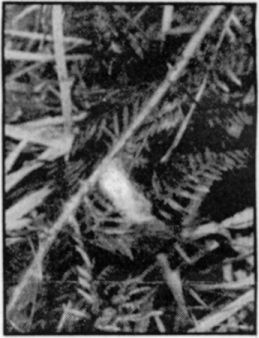 |
What I have described here is the basic preparation Tom gives
you to be able to track -- how to observe, how to prepare yourself mentally for
the task at hand.
We learned to feel tracks with our fingers -- first in the
classroom with a cup full of sand, and then in the field in the dark of night.
We tracked elk across a field in total darkness. It was amazing how easy it was
to feel a track and then to know where the next track should be. Perhaps what
was really amazing was that the next track was where you thought it should be.
Once we were properly prepared to find tracks and follow them
in either daylight or darkness, Tom began to describe how to analyze them and to
more fully learn what the track was telling us. He could only tell us so much --
the rest we must learn for ourselves by observing an animal and then studying
the tracks that it left.
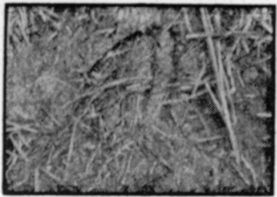 |
Since we have only one track
and it is net readily apparent whether it is right or left side, we can
only talk about the track in "what if" terms. If this is a
right hand set of prints, then it is the prints of a buck deer because
the front track falls outside of the rear track. If however it is a left
had set of tracks, it is a doe. |
He taught us to make a tracking box to study
the ageing of tracks and to study what tracks are telling you.
One thing I did learn: it will take a lot of
time and study to become a good tracker -- more time than most of us will ever
be able to devote to the subject But I've learned enough so that I can follow a
set of tracks much better than I could before I went to this class. And I
believe I could now backtrack myself if I became lost and could find my way out.
This, in itself, is a comforting feeling and made the class worthwhile.
|
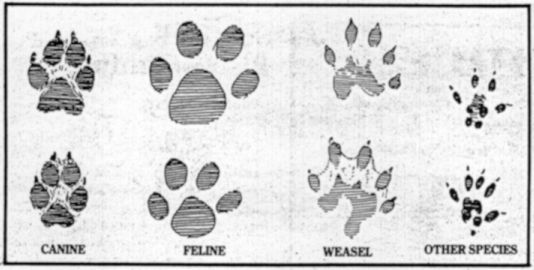
|
| There are four basic toe patterns in
animals: four toes up front and four toes in the rear with claw marks
showing equals the Canine family; four toes up front and four toes in
the rear with no claw marks is the Feline (cat) family; five toes up
front and five toes in the rear is the weasel family; and four toes up
front and five toes in the rear covers most other species. |
Previous
Contents Next
|

